|
Additional Lessons |
 About These
Lessons About These
Lessons
The following classroom lessons are great for students
who want additional listening and reading practice. |
-
Travel America -
Beginner
Level. Do you love America and American
English? Learn before you travel. Facts and other
cool stuff about your favorite U.S. state. Great
English reading practice.
|
 Travel
America - Florida Travel
America - Florida
(Beginner -
Reading)
Learn some interesting facts and read interesting
stories about Florida. |
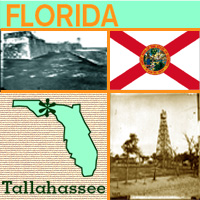 Florida Florida
Called the "Sunshine State," Florida is known for
its balmy, sunny weather and beautiful beaches.
Ponce de Leon, in search of the elusive fountain of
youth, was the first European to explore Florida.
St. Augustine, founded by the Spanish in 1565, is
the oldest permanent European settlement in the
continental United States. Statehood for Florida
came in 1845. Florida's state flower is the orange
blossom, which is particularly fitting because
oranges are a main export of the state. Because of
its shape and location, a long peninsula between the
Atlantic Ocean and the Gulf of Mexico, Florida
attracts millions of visitors each year to its many
seaside resort areas. Its capital is Tallahassee. |
Florida
State Flag
The original 1868 flag of Florida was simply the
Florida state seal centered on a field of white. In the
1890's, Florida's governor suggested adding the red cross so
the flag would not look like a banner of truce or surrender
when hanging limp on a flagpole. Florida voters agreed and
an amendment to Florida's constitution was made in 1900
which describes the current design.
Many banners have flown over Florida prior to 1868,
including the flags of Spain, France, Great Britain, the
Confederate States, and the national flag of the USA.
Seal of Florida
The Florida state seal was adopted by the 1865 Legislature,
which mandated that the seal be the size of the American
silver dollar and display a scene in the center "of the
sun's rays over a high land in the distance, a cocoa tree, a
steamboat on water, and an Indian female scattering flowers
in the foreground, (all) encircled by the words Great Seal
of the State of Florida: In God We Trust."
In 1970 Florida's official seal was updated. The cocoa tree
became a Sabal palmetto palm (the state tree of Florida),
the headdress was removed from the Native American woman
(headdresses were only worn by men), and the woman was
depicted as a Florida Seminole (originally she was dressed
as a Native American of the western Plains). |
|
Source:
State Symbols USA |
|
|
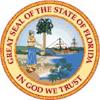 Florida
State Facts Florida
State Facts
Picture: state seal of Florida |
|
State Capital |
Tallahassee |
|
Nickname |
Sunshine State / Peninsula State |
|
Motto |
In God We Trust |
|
Statehood |
March 3, 1845 (27th) |
|
Origin of Name |
Named on Easter 1513 by Ponce de Leon for Pascua
Florida, meaning "Flowery Easter." |
|
Largest Cities |
Jacksonville, Miami, Tampa, Saint Petersburg,
Hialeah |
|
Border States |
Alabama, Georgia |
|
Area |
53,997 sq. mi., 26th largest |
|
State Bird |
Mockingbird |
|
State Flower |
Orange blossom (citrus sinensis) |
|
State Tree |
Sabal Palmetto (cabbage palmetto) |
|
State Song |
Suwannee River |
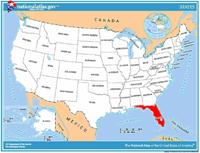 Travel
and tourism site for Florida - This state travel
and territorial tourism site provides ideas for your
vacations, meetings, and more. Travel
and tourism site for Florida - This state travel
and territorial tourism site provides ideas for your
vacations, meetings, and more. |
|
|
Florida Stories |
|
|
Chiefland Watermelon Festival
You might know that watermelons are 92 percent water, but did you
know that they came from the Kalahari Desert in Africa?
The first recorded watermelon harvest took place 5,000 years ago in
Egypt. Pictures of the fruit were found in paintings on the walls of
ancient buildings. From there, the fruit spread to other countries
by merchant ships. It is believed that watermelon came to the United
States with African slaves.
The people of Chiefland, Florida, have held a Watermelon Festival
every June since 1954 to celebrate the city's watermelon farmers and
to bring the community together for a family-day celebration. The
festival includes many activities. One of the favorites is a
watermelon seed-spitting contest. Free cold watermelon, donated by
local growers, is served throughout the day. There's also a parade
made up of floats with a watermelon theme, high school bands, fire
engines, and cars featuring contestants of the Watermelon Festival
Queen contest. |
|
|
Myth and Dream: Exploring the Cultural
Legacies of Florida and the Caribbean
The state of Florida is a melting pot of many different cultures.
One of the strongest influences in Florida comes from the Caribbean.
It is so strong that a museum exhibit has even been created called
"Myths and Dreams." It shows some of the effects the Caribbean has
had on Florida and how Florida has affected the Caribbean.
The exhibit also has an Internet site that features some well-known
Floridians. One that you might have heard of is Zora Neale Hurston,
an anthropologist and a writer. Hurston was born in 1903 in
Eatonville, Florida, the first incorporated all black town in the
United States, and she grew up to write stories, novels, plays,
folklore and an autobiography. In 1927, Hurston began traveling
around with a camera to explore the folk tales of Florida, Alabama,
Louisiana and Mississippi. She talked to many people and gathered
hundreds of folk tales, most still unpublished. The tales have been
described as a "cultural window into how people lived." Later she
went on to explore Jamaica, Bermuda, Honduras and Haiti, where she
learned about local Caribbean customs. How would you like to pick a
place and learn about its culture? |
|
|
Thrust into Space: How the Space Program
Changed Brevard County
Hold on, a rocket is blasting off!
A shuttle must reach speeds of about 17,500 miles per hour to remain
in orbit. And Brevard County in Florida is where America's space
program all began. It is home to the John F. Kennedy Space Center of
the National Aeronautics and Space Administration, better known as
NASA.
"Thrust into Space" is the title of a videotape made especially for
the Local Legacies project that documents the flights made from this
Space Center.
Have you ever dreamed of becoming an astronaut?
Can you guess who the youngest astronaut to date is? How about the
oldest astronaut? Sally Ride, the youngest astronaut, was 32 years
old when she flew on the space shuttle in June 1983. The oldest is
John Glenn, who was 77 when he flew on the shuttle in October and
November 1998. |
|
|
Calle Ocho-Miami Carnival
Have you ever tried pinchos, arepas or tamales? These are some of
the foods available at the Calle Ocho festival.
In Miami, Florida, there is a large Cuban American population, and
every year they have a Calle Ocho festival. Calle Ocho (pronounced
kye-yay oh-cho) means "eighth street" in Spanish and is the single
largest celebration of Latino culture in the United States. Eighth
Street is the most popular street in "Little Havana" and is Miami's
center of Cuban culture.
Calle Ocho is an enormous street party, and entire streets are
blocked off to make room for music, dance, visual arts, food and
other fun! Calle Ocho started in 1978 to bring the Hispanic
community together, and it was so popular that although only 10,000
people were expected, more than 100,000 showed up! Each year the
festival grows and today the event is known as Carnaval Miami and is
celebrated over two weekends in March. |
|
|
Edison Pageant of Light
Do you know what the kids in the photo are doing? They are holding
busts of Thomas Edison for a performance in the Edison Pageant of
Light.
The people in Fort Myers, Florida, have been celebrating Thomas
Edison's birthday since February 1938. Edison moved to Fort Myers
with his wife, Mina, for health reasons. In the bright, warm
sunshine and under big blue skies, Edison's health was restored. He
liked Fort Myers so much that he stayed and built a laboratory there
in 1887. Every year he threw himself a birthday party, and important
guests like Harvey Firestone and Henry Ford would attend.
Today, Edison's birthday is celebrated as a three-day event that
includes a royal pageant with the highlight being the crowning of a
king and queen of the mythical realm of Edisonia. Edison's birthday
party also includes many bands and floats, a Baby Parade, fireworks,
stadium show, a flower show, arts and crafts show, golf and tennis
tournaments, professional square dancing and musical performances.
Now that's a big birthday party! But most people would agree that
someone who invented the phonograph, the motion picture camera, and
1,000 other inventions deserves to be honored in this way! |
|
|
Springtime Tallahassee
Tallahassee, Florida, has had a hard time trying to keep the capital
there. There's been talk of moving the capital of Florida out of
Tallahassee since the 1850s! After a bill was introduced in the
state legislature in 1967 to move the capital to Orlando, the
community of Tallahasee came up with the idea of having a festival
in March 1968 to show off the beauty of the city. They called the
festival "Springtime Tallahassee, A Capital Affair." Spring in
Tallahasee is particularly pretty because all of the dogwood trees
and azalea bushes are in full bloom with beautiful flowers.
Since then, Tallahassee has made sure that the capital of Florida
stays put by having this festival every year. Volunteers who
coordinate the festival are organized into five "krewes," each
representing a different period of Florida history: Spanish, U.S.
territory, statehood before the Civil War, the Civil War and
Reconstruction, and the 20th century. Each "krewe" (pronounced
"crew") builds a parade float that reflects one of these periods.
The "krewes" also appear in period costume at a number of gala
events during the festival.
In addition to a parade, the festival also features arts, crafts,
delicious food and music and the colorful Balloon Rally, which is as
colorful as Florida in springtime. |
|
|
Osceola in Florida
The story of Osceola, a Seminole Indian, may not be well known, but
his brave attempts to remain in Florida and fight the U.S.
government are well documented. Osceola was one of the leaders of
the Seminole Indians during the Second Seminole War with the United
States in the 1830s. Although originally from Alabama, Osceola and
his Creek Indian mother moved to Florida, which was the homeland of
the Seminole Indians. When white settlers began moving into the
state, they wanted the Seminoles to move to Indian territories west
of the Mississippi River. Osceola led a group of Seminoles opposed
to relocation. Other Seminoles, however, chose to move rather than
fight.
By using tactics unfamiliar to the white settlers and by hiding in
the Everglades, Osceola and some of the Seminoles were successfully
able to resist the United States government's attempts to remove
them from Florida for a time. It was not until the capture of
Osceola and his death in 1838 at Fort Moultrie in South Carolina
that the Seminoles were forced from their homeland. |
|
|
Florida Territory Becomes Our 27th State
How did the eventual home of Disney World become our 27th State?
Juan Ponce de Leon claimed Florida for Spain in 1513. But the French
were also interested in the territory, and they built Fort Caroline
near the mouth of the St. Johns River 1564. A year later, to
maintain its control over the territory, Spain destroyed Fort
Caroline, and Leon founded our country's oldest continuously settled
city in St. Augustine.
Do you know what other country's peoples arrived in Florida after
that and what they did?
England wanted to expand its colonies and began to threaten Florida
in the 1700s, attacking St. Augustine many times. England, France
and Spain were all fighting with each other in several parts of the
world in the pursuit of growing their colonies. This conflict was
known as both the Seven Years War and the French and Indian Wars.
In 1763 the Treaty of Paris was signed by England, France and Spain
and it resulted in England gaining the Florida Territory. But when
England formally recognized the colonies' independence (as the
United States) in 1783, the Florida Territory was returned to Spain
without clear definition of its boundaries. When we made the
Louisiana Purchase from France, Florida was still without clear
boundaries! How did our government finally get Florida and make it
our 27th state?
With numerous boundary disputes, Spain's claim to Florida grew
shaky. American settlers moved in and began to resist Spanish
control. After years of border arguments, Spain finally agreed to
cede the Florida Territory to the U.S. in 1819 by signing the Adams-Onis
Treaty, signed by Spanish minister Luis de Onis and U.S. Secretary
of State John Quincy Adams. More settlers arrived and Tallahassee
became the capital. Florida was admitted to the Union in 1845. Have
you ever been to Florida or Disney World? |
|
Source:
Library of Congress |
|
 National
Forests, Parks, and Monuments of Florida National
Forests, Parks, and Monuments of Florida
The following is a description of national
forests, parks, and monuments in the state
of Florida. If you plan to visit or live in
Florida for awhile then you should
definitely plan to visit some of these
fantastic places. |
|
|
|
National Forests |
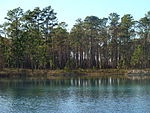 Apalachicola Apalachicola
As the largest National Forest in Florida,
Apalachicola includes over 2,700 acres
(1,100 ha) of water and 67 mi (108 km) of
the Florida Trail. There are caverns and
sinkholes at the Leon Sinks Geological Area,
while Fort Gadsden is along the Apalachicola
River. |
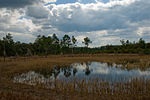 Ocala Ocala
Ocala protects the world's largest sand pine
scrub forest. There are more than 600 lakes,
rivers, and springs in the forest along with
four wilderness areas. There are over 600
lakes and part of the Florida Trail in the
forest. |
 Osceola Osceola
The Big Gum Swamp Wilderness is the forest's
only wilderness area, and the Osceola
Research Natural Area was designated a
National Natural Landmark in 1974. The Civil
War Battle of Olustee occurred in what is
now the forest, and 23 mi (37 km) of the
Florida National Scenic Trail pass through
the forest. |
|
|
|
National Parks |
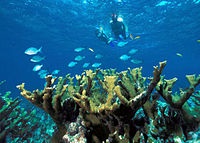 Biscayne Biscayne
Located in Biscayne Bay, this park at the
north end of the Florida Keys has four
interrelated marine ecosystems: mangrove
forest, the Bay, the Keys, and coral reefs.
Threatened animals include the West Indian
manatee, American crocodile, various sea
turtles, and peregrine falcon. |
 Dry
Tortugas Dry
Tortugas
The islands of the Dry Tortugas, at the
westernmost end of the Florida Keys, are the
site of Fort Jefferson, a Civil War-era fort
that is the largest masonry structure in the
Western Hemisphere. The park is home to
undisturbed coral reefs and shipwrecks, and
is only accessible by plane or boat. |
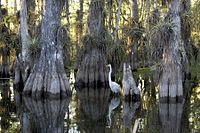 Everglades Everglades
The Everglades are the largest tropical
wilderness in the United States. This
mangrove and tropical rainforest ecosystem
and marine estuary is home to 36 protected
species, including the Florida panther,
American crocodile, and West Indian manatee.
Some areas have been drained and developed;
restoration projects aim to restore the
ecology. |
|
|
|
National Monuments |
 Castillo
de San Marcos Castillo
de San Marcos
This Spanish fort near St. Augustine, called
Fort Marion when first protected, served for
205 years under four different flags. Built
in 1672, it was involved in sieges with the
British while under Spanish command, the
American Revolution under Britain, the Civil
War under the Confederacy, and the Seminole
Wars and the Spanish–American War under the
United States. |
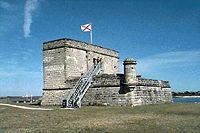 Fort
Matanzas Fort
Matanzas
This 1740 Spanish fort guarded Matanzas
Inlet, the southern mouth of the Matanzas
River, which allowed access to St.
Augustine. The monument is managed in
conjunction with Castillo de San Marcos
National Monument and also protects 100
acres (0.40 km2) of salt marsh and barrier
islands. |
|
|
Travel America |
|
|
Biscayne Islands National Park
(Beginner - Listening,
reading)
A video lesson which shows you an interesting place in America.
The English is
spoken at 75% of normal speed.
Great English listening and reading practice.
This video is all about Biscayne Islands National Park. |
|
 Travel
America Travel
America
Do you love America and American English? Learn before
you travel. Facts and other cool stuff about your
favorite U.S. state. Visit the Fun Easy English Travel
America pages. Read about the beautiful National
Forests, Parks, and Monuments. Great English reading practice. |
 Drive America Drive America
Planning to drive in America? Learn the rules and
regulations. Great English reading practice. |
|